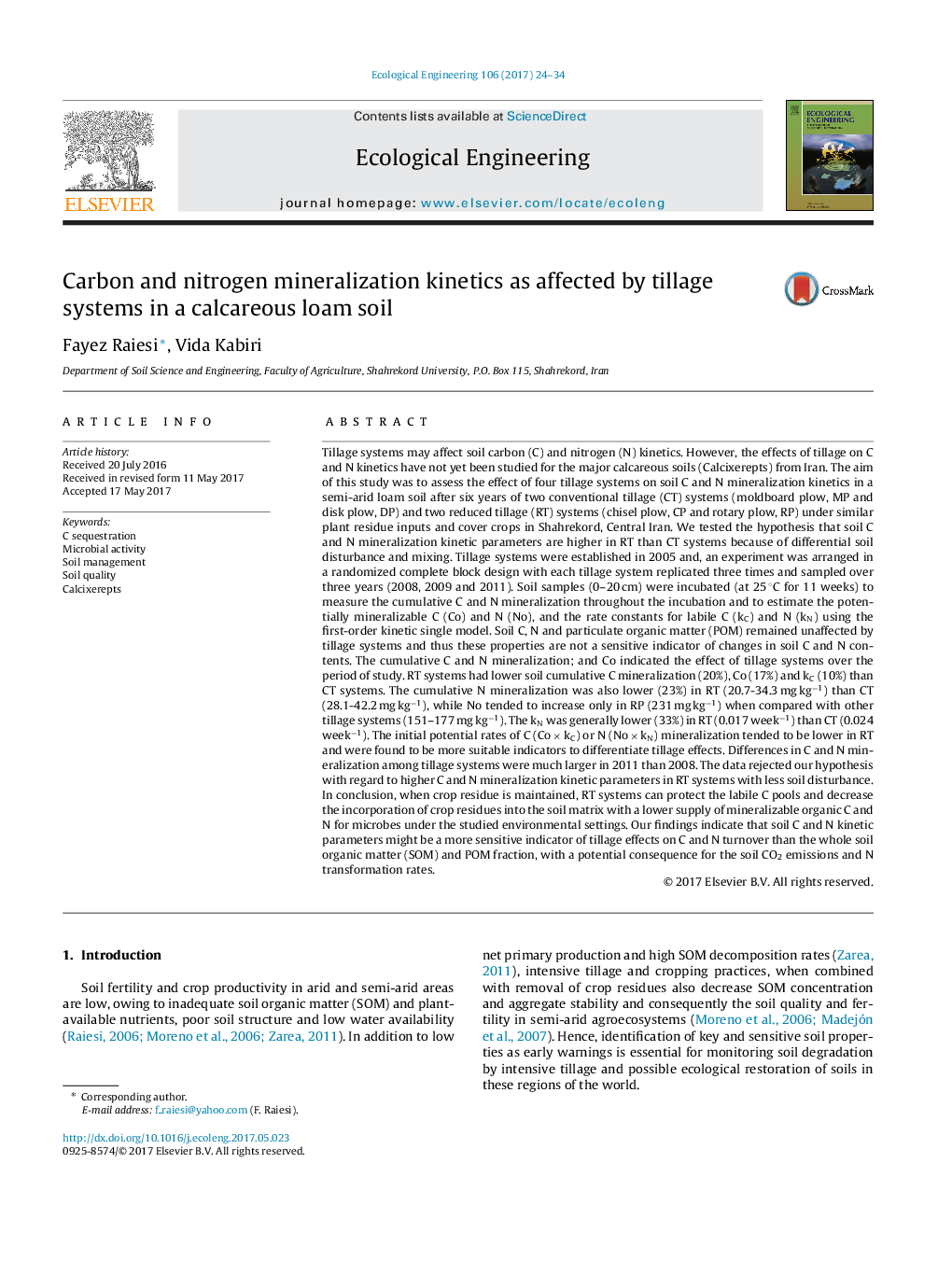| کد مقاله | کد نشریه | سال انتشار | مقاله انگلیسی | نسخه تمام متن |
|---|---|---|---|---|
| 5743819 | 1412322 | 2017 | 11 صفحه PDF | دانلود رایگان |
عنوان انگلیسی مقاله ISI
Carbon and nitrogen mineralization kinetics as affected by tillage systems in a calcareous loam soil
ترجمه فارسی عنوان
سینتیک کربن و کربنات نیتروژن تحت تاثیر سیستم های خاکورزی در یک خاک لوم آهکی
دانلود مقاله + سفارش ترجمه
دانلود مقاله ISI انگلیسی
رایگان برای ایرانیان
کلمات کلیدی
موضوعات مرتبط
علوم زیستی و بیوفناوری
علوم کشاورزی و بیولوژیک
بوم شناسی، تکامل، رفتار و سامانه شناسی
چکیده انگلیسی
Tillage systems may affect soil carbon (C) and nitrogen (N) kinetics. However, the effects of tillage on C and N kinetics have not yet been studied for the major calcareous soils (Calcixerepts) from Iran. The aim of this study was to assess the effect of four tillage systems on soil C and N mineralization kinetics in a semi-arid loam soil after six years of two conventional tillage (CT) systems (moldboard plow, MP and disk plow, DP) and two reduced tillage (RT) systems (chisel plow, CP and rotary plow, RP) under similar plant residue inputs and cover crops in Shahrekord, Central Iran. We tested the hypothesis that soil C and N mineralization kinetic parameters are higher in RT than CT systems because of differential soil disturbance and mixing. Tillage systems were established in 2005 and, an experiment was arranged in a randomized complete block design with each tillage system replicated three times and sampled over three years (2008, 2009 and 2011). Soil samples (0-20 cm) were incubated (at 25 °C for 11 weeks) to measure the cumulative C and N mineralization throughout the incubation and to estimate the potentially mineralizable C (Co) and N (No), and the rate constants for labile C (kC) and N (kN) using the first-order kinetic single model. Soil C, N and particulate organic matter (POM) remained unaffected by tillage systems and thus these properties are not a sensitive indicator of changes in soil C and N contents. The cumulative C and N mineralization; and Co indicated the effect of tillage systems over the period of study. RT systems had lower soil cumulative C mineralization (20%), Co (17%) and kC (10%) than CT systems. The cumulative N mineralization was also lower (23%) in RT (20.7-34.3 mg kgâ1) than CT (28.1-42.2 mg kgâ1), while No tended to increase only in RP (231 mg kgâ1) when compared with other tillage systems (151-177 mg kgâ1). The kN was generally lower (33%) in RT (0.017 weekâ1) than CT (0.024 weekâ1). The initial potential rates of C (Co Ã kC) or N (No Ã kN) mineralization tended to be lower in RT and were found to be more suitable indicators to differentiate tillage effects. Differences in C and N mineralization among tillage systems were much larger in 2011 than 2008. The data rejected our hypothesis with regard to higher C and N mineralization kinetic parameters in RT systems with less soil disturbance. In conclusion, when crop residue is maintained, RT systems can protect the labile C pools and decrease the incorporation of crop residues into the soil matrix with a lower supply of mineralizable organic C and N for microbes under the studied environmental settings. Our findings indicate that soil C and N kinetic parameters might be a more sensitive indicator of tillage effects on C and N turnover than the whole soil organic matter (SOM) and POM fraction, with a potential consequence for the soil CO2 emissions and N transformation rates.
ناشر
Database: Elsevier - ScienceDirect (ساینس دایرکت)
Journal: Ecological Engineering - Volume 106, Part A, September 2017, Pages 24-34
Journal: Ecological Engineering - Volume 106, Part A, September 2017, Pages 24-34
نویسندگان
Fayez Raiesi, Vida Kabiri,
